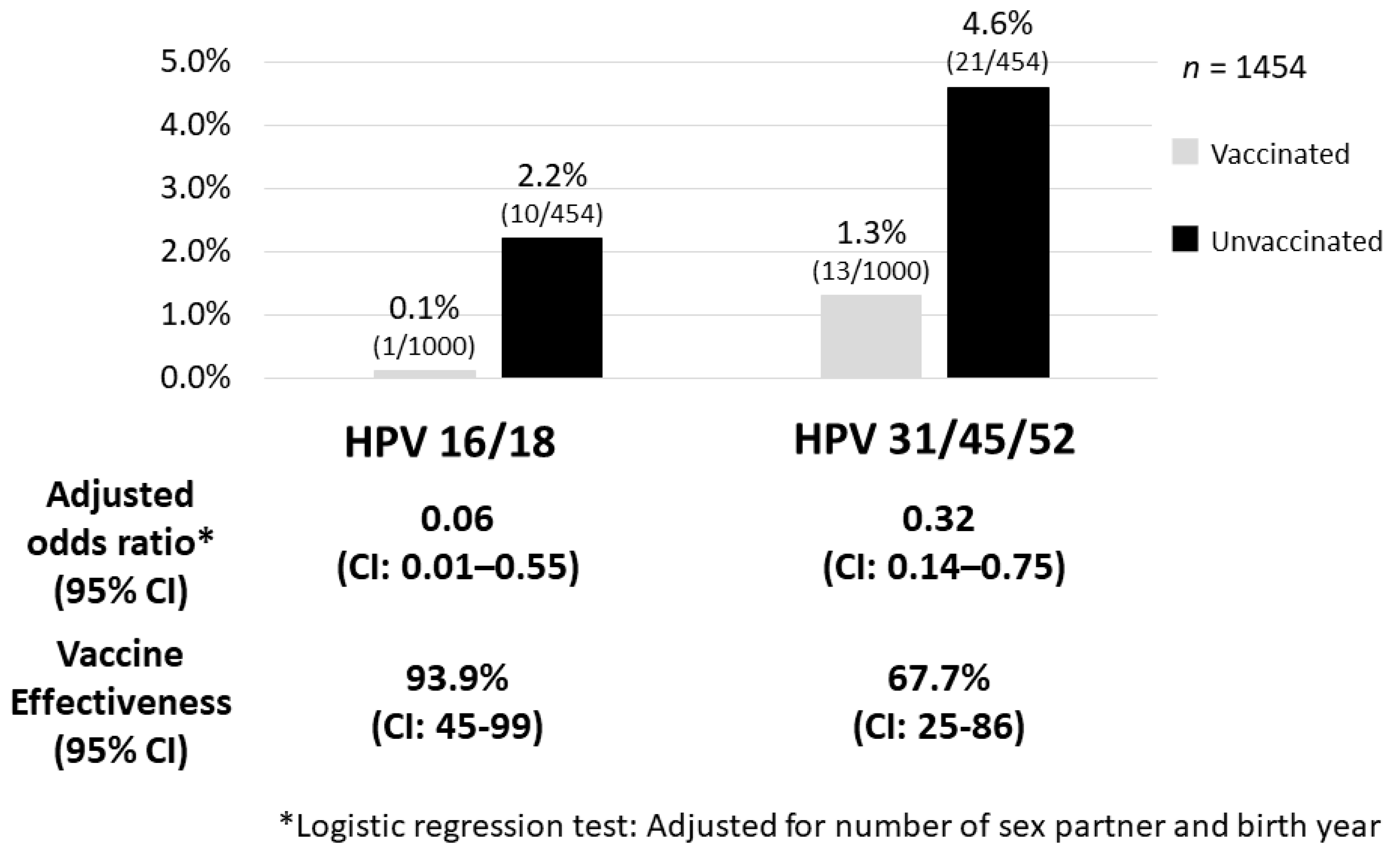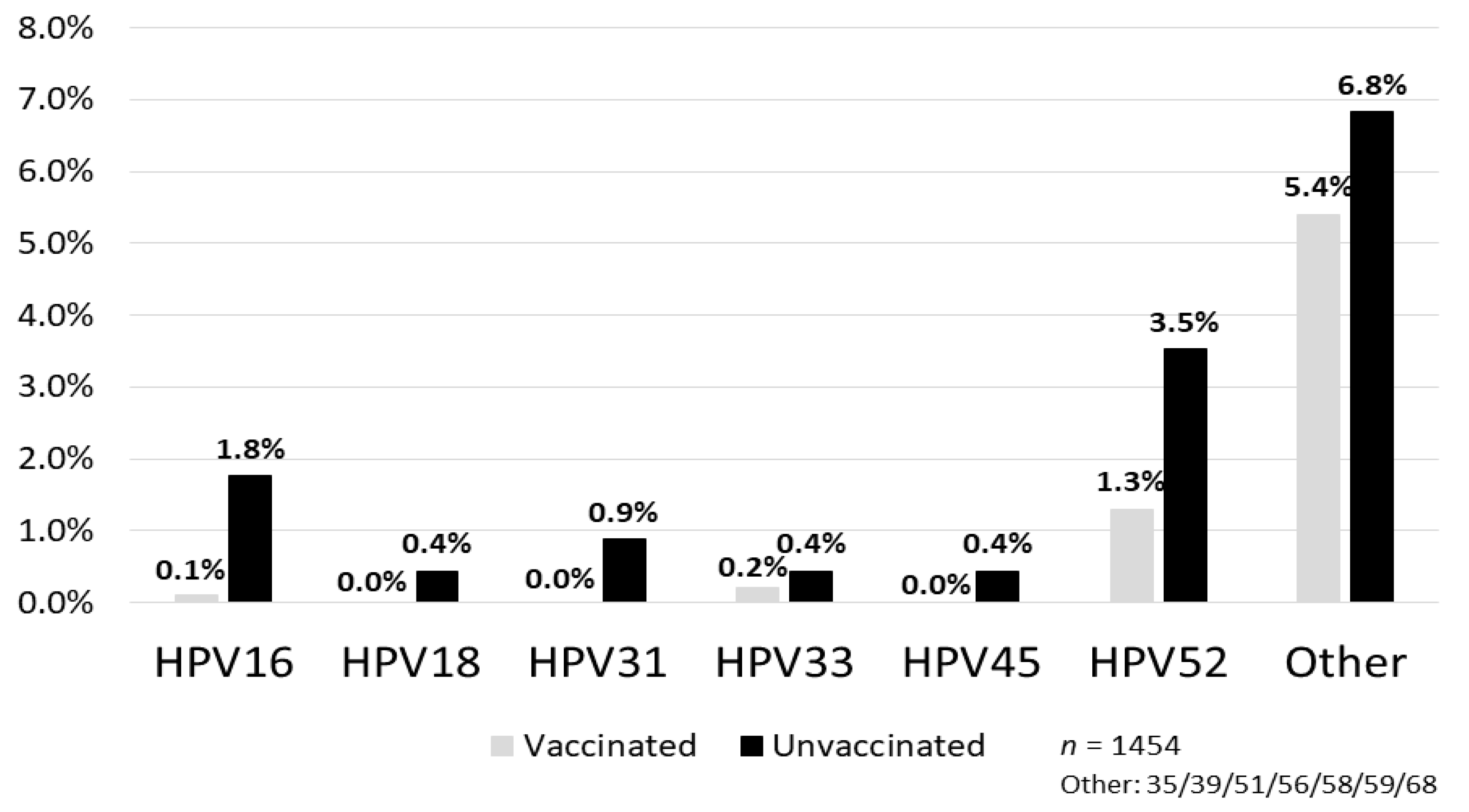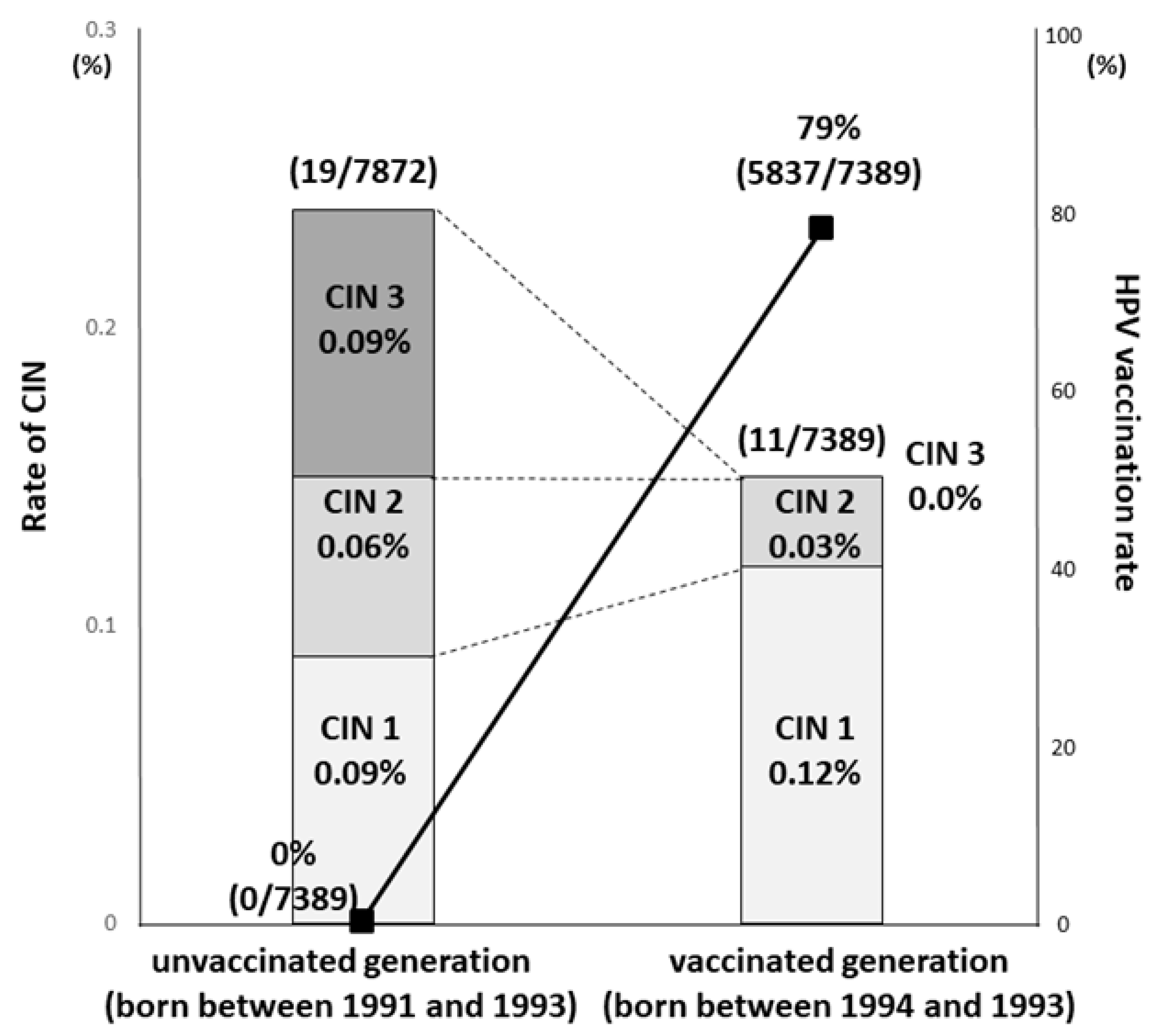Japan’s Ongoing Crisis on HPV Vaccination
Abstract
1. Introduction
2. Efficacy of the HPV Vaccine as a Preventative for Cervical Cancer
2.1. Preventive Effect for HPV Infection
2.2. Preventive Effect for Cytological Abnormalities
2.3. Preventive Effect for Histological Abnormalities
2.4. Impact of Suspension of Proactive Recommendations
3. Discussions Related to Safety of the HPV Vaccine
4. Prospects for the Future
Author Contributions
Funding
Acknowledgments
Conflicts of Interest
References
- Cancer Information Service, National Cancer Center, Japan. Cancer Registry and Statistics. Available online: https://ganjoho.jp/reg_stat/statistics/dl/ (accessed on 1 June 2020).
- Motoki, Y.; Mizushima, S.; Taguri, M.; Takahashi, K.; Asano, R.; Kato, H.; Asai-Sato, M.; Katayama, K.; Okamoto, N.; Hirahara, F.; et al. Increasing trends in cervical cancer mortality among young Japanese women below the age of 50 years: An analysis using the kanagawa population-based cancer registry, 1975–2012. Cancer Epidemiol. 2015, 39, 700–706. [Google Scholar] [CrossRef] [PubMed]
- Sauvaget, C.; Nishino, Y.; Konno, R.; Tase, T.; Morimoto, T.; Hisamichi, S. Challenges in breast and cervical cancer control in Japan. Lancet Oncol. 2016, 17, e305–e312. [Google Scholar] [CrossRef]
- OECD Stat. Health Care Utilisation: Screening. Available online: https://stats.oecd.org/index.aspx?queryid=30159 (accessed on 1 June 2020).
- Yamaguchi, M.; Sekine, M.; Kudo, R.; Adachi, S.; Ueda, Y.; Miyagi, E.; Hara, M.; Hanley, S.J.; Enomoto, T. Differential misclassification between self-reported status and official HPV vaccination records in Japan: Implications for evaluating vaccine safety and effectiveness. Papillomavirus Res. (Amst. Neth.) 2018, 6, 6–10. [Google Scholar] [CrossRef] [PubMed]
- Kudo, R.; Yamaguchi, M.; Sekine, M.; Adachi, S.; Ueda, Y.; Miyagi, E.; Hara, M.; Hanley, S.J.B.; Enomoto, T. Bivalent Human Papillomavirus Vaccine Effectiveness in a Japanese Population: High Vaccine-Type–Specific Effectiveness and Evidence of Cross-Protection. J. Infect. Dis. 2018, 219, 382–390. [Google Scholar] [CrossRef] [PubMed]
- Yagi, A.; Ueda, Y.; Egawa-Takata, T.; Tanaka, Y.; Nakae, R.; Morimoto, A.; Terai, Y.; Ohmichi, M.; Ichimura, T.; Sumi, T.; et al. Realistic fear of cervical cancer risk in Japan depending on birth year. Hum. Vaccines Immunother. 2017, 13, 1700–1704. [Google Scholar] [CrossRef] [PubMed]
- Japan Society of Obstetrics and Gynecology: For the Current Knowledge and Correct Understanding of Cervical Cancer and HPV Vaccine. Available online: https://www.jsog.or.jp/uploads/files/jsogpolicy/HPV_Q%26A.pdf (accessed on 1 June 2020).
- Azuma, Y.; Kusumoto-Matsuo, R.; Takeuchi, F.; Uenoyama, A.; Kondo, K.; Tsunoda, H.; Nagasaka, K.; Kawana, K.; Morisada, T.; Iwata, T.; et al. Human papillomavirus genotype distribution in cervical intraepithelial neoplasia grade 2/3 and invasive cervical cancer in Japanese women. Jpn. J. Clin. Oncol. 2014, 44, 910–917. [Google Scholar] [CrossRef] [PubMed]
- Matsumoto, K.; Yoshikawa, H. Human papillomavirus infection and the risk of cervical cancer in Japan. J. Obstet. Gynaecol. Res. 2012, 39, 7–17. [Google Scholar] [CrossRef] [PubMed]
- Ozawa, N.; Ito, K.; Tase, T.; Metoki, H.; Yaegashi, N. Beneficial Effects of Human Papillomavirus Vaccine for Prevention of Cervical Abnormalities in Miyagi, Japan. Tohoku J. Exp. Med. 2016, 240, 147–151. [Google Scholar] [CrossRef] [PubMed][Green Version]
- Tanaka, H.; Shirasawa, H.; Shimizu, D.; Sato, N.; Ooyama, N.; Takahashi, O.; Terada, Y. Preventive effect of human papillomavirus vaccination on the development of uterine cervical lesions in young Japanese women. J. Obstet. Gynaecol. Res. 2017, 43, 1597–1601. [Google Scholar] [CrossRef] [PubMed]
- Ueda, Y.; Yagi, A.; Nakayama, T.; Hirai, K.; Ikeda, S.; Sekine, M.; Miyagi, E.; Enomoto, T. Dynamic changes in Japan’s prevalence of abnormal findings in cervical cervical cytology depending on birth year. Sci. Rep. 2018, 8, 5612. [Google Scholar] [CrossRef] [PubMed]
- Konno, R.; Konishi, H.; Sauvaget, C.; Ohashi, Y.; Kakizoe, T. Effectiveness of HPV vaccination against high grade cervical lesions in Japan. Vaccine 2018, 36, 7913–7915. [Google Scholar] [CrossRef] [PubMed]
- Matsumoto, K.; Yaegashi, N.; Iwata, T.; Ariyoshi, K.; Fujiwara, K.; Shiroyama, Y.; Usami, T.; Kawano, Y.; Horie, K.; Kawano, K.; et al. Monitoring the Impact of a National HPV Vaccination Program in Japan (MINT Study): Rationale, Design and Methods. Jpn. J. Clin. Oncol. 2014, 44, 1000–1003. [Google Scholar] [CrossRef] [PubMed][Green Version]
- Matsumoto, K.; Yaegashi, N.; Iwata, T.; Yamamoto, K.; Nagashima, M.; Saito, T.; Ushijima, K.; Takahashi, F.; Noda, K.; Yoshikawa, H. Early impact of the Japanese immunization program implemented before the HPV vaccination crisis. Int. J. Cancer 2017, 141, 1704–1706. [Google Scholar] [CrossRef] [PubMed]
- Yagi, A.; Ueda, Y.; Ikeda, S.; Sekine, M.; Nakayama, T.; Miyagi, E.; Enomoto, T. Evaluation of future cervical cancer risk in Japan, based on birth year. Vaccine 2019, 37, 2889–2891. [Google Scholar] [CrossRef] [PubMed]
- Tanaka, Y.; Ueda, Y.; Egawa-Takata, T.; Yagi, A.; Yoshino, K.; Kimura, T. Outcomes for girls without HPV vaccination in Japan. Lancet Oncol. 2016, 17, 868–869. [Google Scholar] [CrossRef]
- The 15th Vaccination Sub-committee Meeting: Investigative Committee on Adverse Reactions, Health Sciences Council, Ministry of Health, Labour, and Welfare (17 September 2015). Available online: https://www.mhlw.go.jp/stf/shingi2/0000097690.html (accessed on 1 June 2020).
- Arbyn, M.; Xu, L. Efficacy and safety of prophylactic HPV vaccines. A Cochrane review of randomized trials. Expert Rev. Vaccines 2018, 17, 1085–1091. [Google Scholar] [CrossRef] [PubMed]
- WHO. Draft Global Strategy towards the Elimination of Cervical Cancer as a Public Health Problem. Available online: http://www.jsog.or.jp/uploads/files/jsogpolicy/WHO-slides_CxCaElimination.pdf (accessed on 1 June 2020).
- The 23th Vaccination Sub-Committee Meeting: Investigative Committee on Adverse Reactions, Health Sciences Council, Ministry of Health, Labour, and Welfare (26 December 2016). Available online: https://www.mhlw.go.jp/stf/shingi2/0000150170.html (accessed on 1 June 2020).
- Suzuki, S.; Hosono, A. No association between HPV vaccine and reported post-vaccination symptoms in Japanese young women: Results of the Nagoya study. Papillomavirus Res. (Amst. Neth.) 2018, 5, 96–103. [Google Scholar] [CrossRef] [PubMed]
- Medical Institutions Involved in the Treatment of Symptoms that Occurred after HPV Vaccination. Available online: https://www.mhlw.go.jp/bunya/kenkou/kekkaku-kansenshou28/medical_institution/dl/kyoyroku.pdf (accessed on 1 June 2020).
- Simms, K.T.; Steinberg, J.; Caruana, M.; Smith, M.A.; Lew, J.B.; Sperjomataram, I.; Castle, P.E.; Bray, F.; Canfell, K. Impact of scaled up human papillomavirus vaccination and cervical screening and the potential for global elimination of cervical cancer in 181 countries, 2020-99: A modelling study. Lancet Oncol. 2019, 20, 394–407. [Google Scholar] [CrossRef]
- Chatterjee, A. The next generation of HPV vaccines: Nonavalent vaccine V503 on the horizon. Expert Rev. Vaccines 2014, 13, 1279–1290. [Google Scholar] [CrossRef] [PubMed]



© 2020 by the authors. Licensee MDPI, Basel, Switzerland. This article is an open access article distributed under the terms and conditions of the Creative Commons Attribution (CC BY) license (http://creativecommons.org/licenses/by/4.0/).
Share and Cite
Sekine, M.; Kudo, R.; Yamaguchi, M.; J. B. Hanley, S.; Hara, M.; Adachi, S.; Ueda, Y.; Miyagi, E.; Ikeda, S.; Yagi, A.; et al. Japan’s Ongoing Crisis on HPV Vaccination. Vaccines 2020, 8, 362. https://doi.org/10.3390/vaccines8030362
Sekine M, Kudo R, Yamaguchi M, J. B. Hanley S, Hara M, Adachi S, Ueda Y, Miyagi E, Ikeda S, Yagi A, et al. Japan’s Ongoing Crisis on HPV Vaccination. Vaccines. 2020; 8(3):362. https://doi.org/10.3390/vaccines8030362
Chicago/Turabian StyleSekine, Masayuki, Risa Kudo, Manako Yamaguchi, Sharon J. B. Hanley, Megumi Hara, Sosuke Adachi, Yutaka Ueda, Etsuko Miyagi, Sayaka Ikeda, Asami Yagi, and et al. 2020. "Japan’s Ongoing Crisis on HPV Vaccination" Vaccines 8, no. 3: 362. https://doi.org/10.3390/vaccines8030362
APA StyleSekine, M., Kudo, R., Yamaguchi, M., J. B. Hanley, S., Hara, M., Adachi, S., Ueda, Y., Miyagi, E., Ikeda, S., Yagi, A., & Enomoto, T. (2020). Japan’s Ongoing Crisis on HPV Vaccination. Vaccines, 8(3), 362. https://doi.org/10.3390/vaccines8030362







